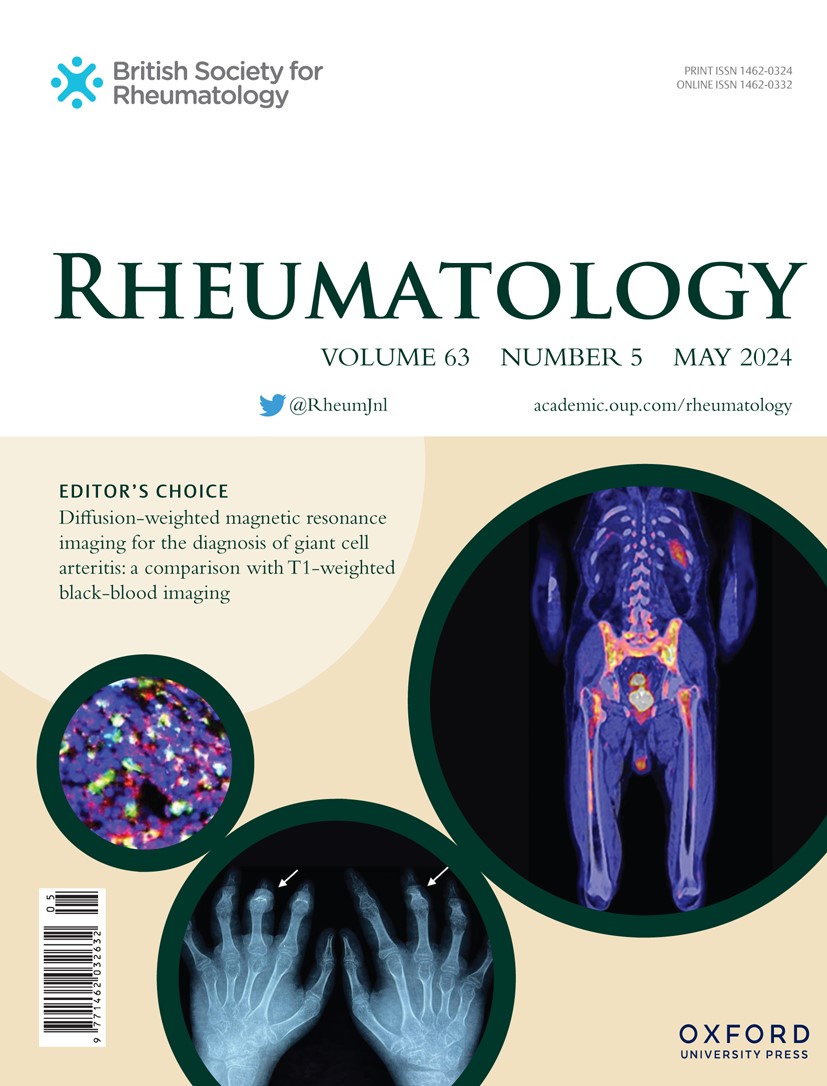Cardiovascular and venous thromboembolic events in systemic sclerosis: epidemiological analysis of the Clinical Practice Research Datalink
IF 4.7
2区 医学
Q1 RHEUMATOLOGY
引用次数: 0
Abstract
Objectives Cardiovascular disease is a leading cause of mortality in systemic sclerosis (SSc). We investigated the association between SSc and the occurrence of both cardiovascular and thromboembolic events using the Clinical Practice Research Datalink (CPRD). Methods A validated case-ascertainment strategy identified SSc patients in the CPRD. A cohort study design examined rates of coronary arterial disease (CAD), cerebrovascular disease, peripheral artery disease (PAD) and venous thromboembolism (VTE) in SSc patients matched to non-SSc comparators by age, sex and location in a 1:6 ratio. Prevalent and incident cases of SSc were analysed separately. Cox regression analysis was used to determine hazard ratios for event occurrence, adjusted for traditional cardiovascular risk factors. Results We identified 877 eligible incident cases of SSc who were matched to 5262 patients without SSc (83.7% female), with a mean follow-up of 8 years. We identified a higher background prevalence of CAD, PAD and VTE at baseline (pre-dating diagnosis) in the SSc cohort. There was a significantly increased risk of CAD, PAD, peripheral venous thromboses and pulmonary embolism during follow up in SSc compared with the non-SSc group (adjusted hazard ratios between 1.84–3.01), particularly amongst males. There was no increased risk of cerebrovascular disease. Conclusions We have identified an increased risk of cardiovascular events and VTE, both prior to a diagnosis of SSc and within 8 years of SSc diagnosis. Work is needed to establish the mechanism of arterial/venous thrombotic events in SSc. Such insight will facilitate more targeted and effective preventative strategies and improve outcomes in SSc.系统性硬化症的心血管和静脉血栓栓塞事件:临床实践研究数据链的流行病学分析
目的心血管疾病是系统性硬化症(SSc)的主要死亡原因。我们使用临床实践研究数据链(CPRD)调查了SSc与心血管和血栓栓塞事件发生之间的关系。方法采用一种经过验证的病例确定策略,对CPRD中的SSc患者进行鉴定。一项队列研究设计检测了SSc患者与非SSc比较者的冠状动脉疾病(CAD)、脑血管疾病、外周动脉疾病(PAD)和静脉血栓栓塞(VTE)的发生率,按年龄、性别和位置按1:6的比例进行匹配。对SSc的流行病例和发病病例分别进行分析。采用Cox回归分析确定事件发生的危险比,并对传统心血管危险因素进行校正。结果877例符合条件的SSc患者与5262例非SSc患者(83.7%为女性)相匹配,平均随访8年。我们发现,在SSc队列中,CAD、PAD和VTE在基线(诊断前)的背景患病率较高。在随访期间,与非SSc组相比,SSc组CAD、PAD、外周静脉血栓形成和肺栓塞的风险显著增加(调整后的风险比在1.84-3.01之间),尤其是在男性中。脑血管疾病的风险没有增加。结论:在SSc诊断前和SSc诊断后8年内,我们已经确定心血管事件和静脉血栓栓塞的风险增加。SSc中动脉/静脉血栓形成事件的机制有待进一步研究。这将有助于制定更有针对性和更有效的预防战略,并改善南南合作的成果。
本文章由计算机程序翻译,如有差异,请以英文原文为准。
求助全文
约1分钟内获得全文
求助全文
来源期刊

Rheumatology
医学-风湿病学
CiteScore
9.40
自引率
7.30%
发文量
1091
审稿时长
2 months
期刊介绍:
Rheumatology strives to support research and discovery by publishing the highest quality original scientific papers with a focus on basic, clinical and translational research. The journal’s subject areas cover a wide range of paediatric and adult rheumatological conditions from an international perspective. It is an official journal of the British Society for Rheumatology, published by Oxford University Press.
Rheumatology publishes original articles, reviews, editorials, guidelines, concise reports, meta-analyses, original case reports, clinical vignettes, letters and matters arising from published material. The journal takes pride in serving the global rheumatology community, with a focus on high societal impact in the form of podcasts, videos and extended social media presence, and utilizing metrics such as Altmetric. Keep up to date by following the journal on Twitter @RheumJnl.
 求助内容:
求助内容: 应助结果提醒方式:
应助结果提醒方式:


